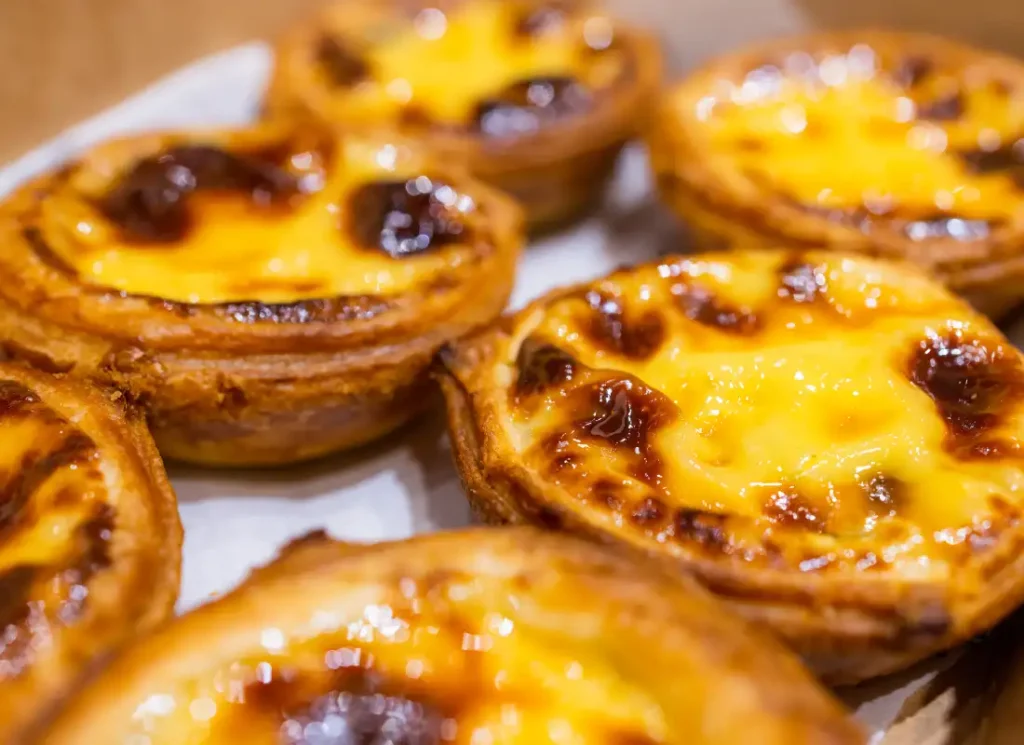This week Zsófi is talking Portuguese desserts and pastries, specifically: what you can find in a Portuguese pasteleria, and how to order them when you don’t know any Portuguese!
——
“What should we do in Lisbon?” asked my flatmate one afternoon as she emerged from her room, smiling ear to ear, having just booked a city break in the sunlit capital of Portugal. As a former resident and a lifelong fan of the city, my mind was instantly filled with various ideas for recommendations.
A bike ride around the cliffy seaside of Cascais is unmissable. The secluded beaches hidden in lush greenery around Sintra are a must. The viewpoints on top of one of the many hills in Lisbon city centre are breathtaking. The Berardo Museum for Contemporary Art is worth every penny. However, in the midst of all my mental chaos, what I actually blurted out, in true foodie-fashion, was: you absolutely have to go to a Portuguese pastelaria.
Jump back to our European Food section
What is a Pastelaria?
Now, if there is one generalisation to make about the Portuguese, it has to be that they LOVE their pastries and bread. Everywhere you go, every isolated village or quiet residential area, will offer you plenty of opportunity to buy fresh pastries or desserts. And these opportunities come in the form of pastelarias.
A pastelaria can be translated as a pastry shop but it is so much more than that. It is a place to have your morning coffee and/or breakfast, your afternoon snack, or your lunch even. Pastelarias will sell coffee in any shape or form, alongside many other hot drinks. You can buy pastries, toasts and toasties, and a wide range of sweet desserts there. You can sit there for hours, basking in the warmth of the sun, and enjoying the unhurried and peaceful life many in this small Iberian nation live.
Portuguese pastry making has a long tradition. It links back to the start of the famous Port wine industry in which it became common practise to use egg whites for a refined filtering process. This resulted in a surplus of egg yolks that, in an effort to avoid food waste, the Portuguese started mixing with other widely available ingredients like cinnamon and sugar to create different kinds of pastries.
It is these three ingredients that remain the principal components of Portuguese baking to this day: just think about the delicious egg cream filling and cinnamon topping of the Portuguese national dessert, the custard tarts! Another interesting theory for why egg yolks are so heavily featured in Portuguese pastries is due to the fact that nuns in convents used to iron their habits using exactly three egg whites. They, too, ended up with some extra egg yolks as a result of this practice that they found a use for in the kitchen.
Read more in European Food: Is British Food Really All That Bad?

Now, it would be remiss if I didn’t issue a small warning here: pastelarias are not made for tourists. This is where people born and raised in Portugal enjoy their breakfasts while reading Público, get together with their neighbours for the latest gossip, or simply get their daily sugar fix. This, of course, means that if you do take my advice and visit one, you will catch an unfiltered glimpse of local life you might not have a chance to see in other, perhaps more touristy places.
It also means that prices are kept consistently low – I’m looking at you budget travellers. However, as non-Portuguese speakers are few and far between, most local pastelarias will not label or, God forbid, translate the names of their goods – in fact, this would seem almost patronising to a nation so profoundly familiar with every egg-sugar mixture their country has to offer.
For a tourist, this can be an overwhelming experience: how can you know what to order when you don’t understand the options? Well, here is a list of orders you cannot go wrong with in a Portuguese pastelaria so you can enjoy this deeply authentic experience without breaking any sweat at the counter.
Read more in European Food: A Complete Guide to Eastern European Food
What to Order in a Portuguese Pasteleria
Pastel de Nata / Portuguese Custard Tart

Undeniably the most popular of all Portuguese pastries and deservedly so: this surprisingly crunchy tart is filled with delicious egg cream and topped with icing sugar or cinnamon. It is best enjoyed as your first meal of the day with a side of bica, the Portuguese equivalent of an espresso (except they drink it excruciatingly slowly, savouring every sip of coffee in that tiny cup).
Its predecessor, the Pastel de Belém originates from the Belém district of Lisbon where it was invented by the monks of the Jerónimos Monastery. Later, as religious orders were dissolved, the monks struck a deal with a local pastelaria to let them sell the tarts commercially. The tarts that continue to be sold in the Pastelaria de Belém go by the name Pastel de Belém. Those sold across the country (and the world) have come to be known as Pastel de Nata.
Pão de Deus / Bread of God

Another essential breakfast item is the sweet Pão de Deus. This pastry has a brioche-like dough that is often flavoured with lemon zest, rum, or vanilla. It is topped with desiccated coconut cream and eggs. It is beautifully crunchy on the outside while fluffy and soft on the inside. This sweet bread was traditionally consumed on All Saints’ Day but it has now outgrown its origins and become a staple at every pastelaria.
I have to say a Pão de Deus is one of my personal favourites. It has saved me from going hungry (or, well, as my boyfriend would say, scarily hangry) on many busy days or penniless weeks.
Bolo de Arroz / Portuguese Rice Muffins

Standing taller than most muffins or cupcakes of its kind, a Bolo de Arroz is a light and airy pastry perfect for a sultry summer afternoon snack. It is made with a combination of rice and wheat flour, butter, milk, and eggs. If you are not a fan of syrupy-sweet desserts, this is the one for you: it\’s mild in its sweetness and refreshingly lemony. You cannot miss them (literally) as they are always wrapped in a cylinder of white baking paper with a blue writing of Bolo de Arroz on it, in case you did indeed need reminding of just what you were eating.
Bola de Berlim / Portuguese Doughnuts

Named after their likeness to German Berliner doughnuts, Bolas de Berlim are traditional Portuguese doughnuts eaten cut in half with a generous custard filling. Almost opposite to the Bolos de Arroz, these doughnuts are indulgently sweet and creamy. Some pastelarias will serve them without the custard, and if this is your preference, I suggest you order it sem creme.
Arroz Doce / Portuguese Rice Pudding

I have a special fondness in my heart for this dessert as it was served many times in our otherwise lacking university canteen in Lisbon (which, by the way, had a whole separate kitchen for just vegetarian food, isn’t that amazing?). First, I approached it with suspicion due to its jelly-like jiggliness, but my sweet tooth, as ever, was stronger than my caution. In this case, I am grateful that it was. While Arroz Doce is essentially a bowl of sweet rice pudding made with lemon, cinnamon, sugar, and (of course) eggs, it is also very warming, sweet, and homey. It is not by mistake that it became a favourite in Portugal, often eaten homemade at family reunions, but also served in pastelarias and snack bars across the country.


I’m booking my flight back to Lisbon now! Yum, yum!